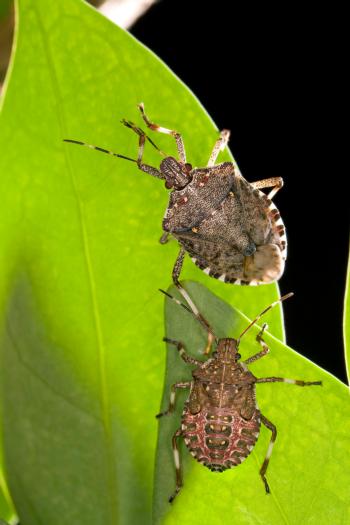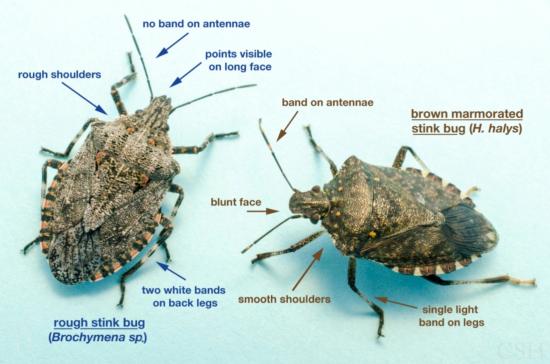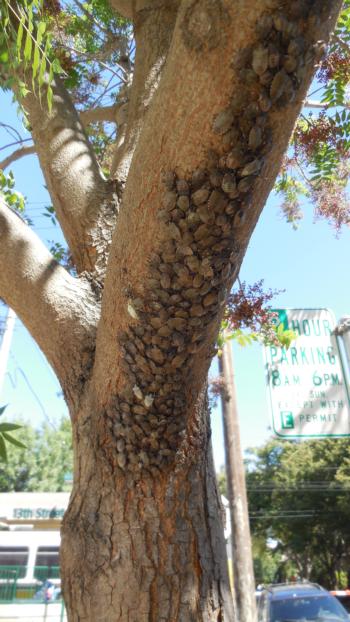The Threat of Brown Marmorated Stink Bug to Nurseries and Floriculture
by Chuck Ingels
The brown marmorated stink bug (BMSB, Halyomorpha halys) is native to East Asia. The first documentation of this species in the United States occurred in Pennsylvania in 2001. It has been found in over 40 U.S. states either as reproducing populations or single finds. BMSB was first found in the western United States in Portland in 2004, and has spread throughout western Oregon and into Washington.
In California, a reproducing population of BMSB was first found in Pasadena and San Marino in Los Angeles County in 2006, and it has since spread to several other cities in that county. In 2013, a large reproducing population was discovered in Sacramento and an infestation was found in Yuba City. Presently, there are many other counties that have reported single finds.
The California Department of Food and Agriculture (CDFA) has given BMSB a pest rating of “B,” so eradication efforts are not practiced. Consistent with this rating, CDFA relies on the Nursery Stock Standards of Cleanliness, which require that nursery stock be free from pests of limited distribution. Any nursery stock for sale in California found in violation of these standards is required to be brought into compliance. Therefore, the county agricultural commissioner can require by written order that nursery stock be held, treated, or disposed of in order to ensure compliance.
According to the Los Angeles County Agricultural Commissioner’s office, so far there have been no BMSB reports or finds in nurseries. However, residents in several cities near Pasadena and San Marino and in some areas in the San Fernando Valley have submitted many BMSB samples, and have reported damage on various fruit trees and ornamentals.
Identification
The adult BMSB is a typically shaped stink bug, about 5/8 inch long and marbled brown. It can be distinguished from other stink bugs of comparable size and color by the following characteristics: the antennae have two distinct white bands, the forward edge of the head is blunt, the upper margin of the shoulder (thorax) is smooth, the legs are marbled brown with faint white bands and a banded abdominal edge is visible to the side of the wings (fig. 1). The beneficial insect, rough stink bug, is commonly mistaken for BMSB, and distinguishing features are shown in fig. 2.

Fig. 1. Adult (top) and late-instar nymph (below), showing characteristic white bands on antennae and legs, blunt forward edge of head, smooth upper shoulders and banded abdominal edges. White bands on legs are clearly visible on nymphs but are often less prominent on adults. Photo courtesy of USDA.
Fig. 2. Comparison of rough stink bug (left) with BMSB (right). Rough stink bug has double points at the tip of the head, narrower shoulder angles and a jagged leading edge of the shoulder. BMSB has a blunt head, wider shoulder angles and smooth shoulders. BMSB also has two white bands on the antennae. Photo by C. Hedstrom, Horticulture Dept., Oregon State University.
Life Cycle
The number of generations per year depends on seasonal temperatures. In the northern United States, there is typically one generation per year and two to three generations in southern portions of the mid-Atlantic. In southern states there can be up to five generations (USDA 2010). The length of time in each stage varies depending on seasonal temperatures. On average, they will develop in 33 to 45 days (Nielsen 2008). The last generation overwinters as adults for about 5 to 7 months, depending on cool-season temperatures. Adults overwinter in tree crevices and buildings, becoming a serious nuisance pest when populations are high. In late summer and fall, adults aggregate in sometimes large numbers as they begin to overwinter (fig. 3).

Fig. 3. Aggregation of adult BMSB on Chinese pistache branch in Sacramento, Sept. 2013. Photo by Baldo Villegas.
Host Crops and Other Plants
BMSB is a serious pest of many fruit, nut and vegetable crops, and it has caused millions of dollars of damage to crops in the mid-Atlantic states. BMSB may reach very high numbers, and since one bug can feed on many fruits, losses can be severe. A table of over 170 host species can be found on StopBMSB.org (http://www.stopbmsb.org/). Major hosts include many ornamental tree species with fruits or pods, such as tree of heaven (Ailanthus altissima), catalpa (Catalpa spp.), redbud (Cercis spp.), English holly (Ilex aquifolium), Southern magnolia (Magnolia grandiflora) and princess tree (Paulownia tomentosa). Only three common flower species appear on the list — cockscombs (Celosia spp.), snapdragon (Antirrhinum majus) and sunflower (Helianthus annuus). Other species reported by Michigan State University Extension (http://msue.anr.msu.edu/news/brown_marmorated_stink_bug_a_new_nursery_pest_in_michigan) are spider flower (Cleome spp.), dahlia (Dahlia spp.) and zinnia (Zinnia elegans). BMSB feeding on ornamental flower species generally hasn’t caused serious damage, but damage was noted on snapdragons in Maryland. The list of host plants will likely grow as the pest spreads to new regions. For example, Chinese pistache was originally not on the list, but was recently added because all BMSB stages were found on these trees in Sacramento in fall 2013.
Damage
BMSB have long, piercing-sucking mouthparts for ingesting plant juices. As they feed they inject enzymes into the plant, which may be toxic to plant tissues. Early-season feeding on fruit by adults and nymphs causes catfacing, dimples, or depressed areas on the surface, and mid-season feeding results in pithy areas internally. BMSB can also feed on leaves, stems and thin trunks as well — they do not cause visible tissue damage initially, but leaves and shoots may become misshapen or deformed.
Monitoring
BMSB traps consist of an inverted clear plastic container with an entry cone opening that is attached to a plastic stand. Two lures are generally used together; one contains methyl decatrienoate (MDT) and the other contains BMSB pheromone. The use of traps for monitoring BMSB is considered relatively ineffective when populations are low, and also generally in late spring. Other monitoring methods include beat-tray sampling and timed searches of foliage. These methods are likely more important than trapping, or used in combination with trapping, especially in field edges bordering riparian areas and on susceptible ornamental species.
Insecticides
BMSB is a new pest so insecticides will play a key role in management, at least until reduced-risk methods are developed. Insecticides used on BMSB include pyrethroids, organophosphates and neonicotinoids; most lose residual efficacy after a few days, likely due to degradation from UV light. Some organic insecticides suppress nymphs but have much less effect on adults.
Current Threat
Once introduced to an area, BMSB can take years to build up population densities high enough to destroy an entire crop. East Coast researchers say it may take up to 8 to 10 years, but in hot areas of California there may be more generations, potentially reducing the time of buildup. Small outbreaks will likely catch some growers off-guard — especially in crops near highway rest stops, mini-storage facilities, and homes and businesses of those who visit infested areas.
View the BMSB Pest Alert and the BSMB identification video at www.ucipm.ucdavis.edu to learn how to identify this pest.
Chuck Ingels is Environmental Horticulture Advisor and Interim County Director, UC Cooperative Extension, Sacramento County
References
Nielsen A. 2008. Developmental rate estimation and life table analysis for Halyomorpha halys (Hemiptera: Pentatomidae). Environ. Entomol. 37(2): 348-355. http://www.ncbi.nlm.nih.gov/pubmed/18419906.
USDA. 2010. Qualitative analysis of the pest risk potential of the brown marmorated stink bug (BMSB), Halyomorpha halys) (Stål), in the United States. Online literature review. 33 p. http://www.michigan.gov/documents/mda/BMSB_Pest_Risk_Potential_-_USDA_APHIS_Nov_2011_344862_7.pdf.












